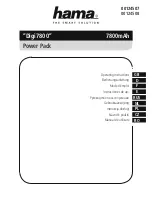
16 Gauge Electric Shear
6
For technical questions call 1-800-665-8685
8343055
V 2.7
EXTENSION CORD
1. As the distance from the supply outlet increases, you must use a heavier gauge extension cord. Using
extension cords with inadequately sized wire causes a serious drop in voltage, resulting in loss of power and
possible tool damage. (See table below)
2. The smaller the gauge number of the wire, the greater the capacity of the cord. For example, a 14 gauge cord
can carry a higher current than a 16 gauge cord. (See table below)
3. When using more than one extension cord to make up the total length, make sure each cord contains at least
the minimum wire size required. (See table below)
4. If you are using an extension cord for more than one tool, add the nameplate amperes and use the sum to
determine the required minimum cord size.
5. If you are using an extension cord outdoors, make sure it is marked with the suffix “W-A” (“W” in Canada) to
indicate if it is acceptable for outdoor use.
6. Make sure your extension cord is properly wired and in good electrical condition. Always replace a damaged
extension cord or have it repaired by a qualified electrician before using it.
7. Protect your extension cords from sharp objects, excessive heat, and damp or wet areas.
Recommended Minimum Wire Gauge for 120 Volt Extension Cords
Nameplate Amperes (at full load) Extension Cord Length
25 ft 50 ft 75 ft 100 ft 150 ft
0 to 2.0
18
18
18
18
16
2.1 to 3.4
18
18
18
16
14
3.5 to 5.0
18
18
16
14
12
5.1 to 7.0
18
16
14
12
12
7.1 to 12.0
16
14
12
10
X
12.1 to 16.0
14
12
10
X
X
16.1 to 20.0
12
10
X
X
X
X – Not recommended for use with extension cord.







































